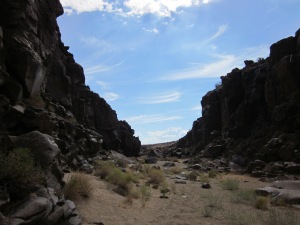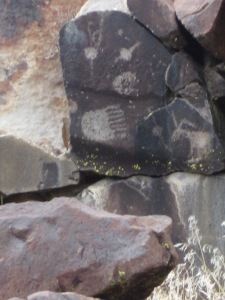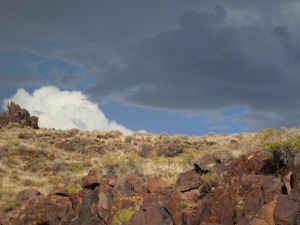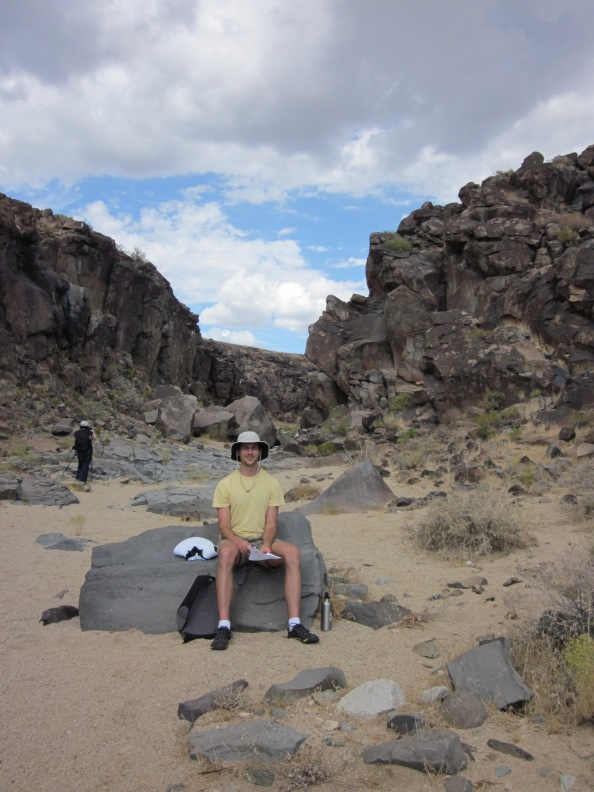Naval Weapons Station, South China Lake
In the scrubby desert north of Los Angeles, a Rhode-Island-sized naval base is the unexpected home for one of North America’s largest collections of prehistoric art, the Little Petroglyph Canyon of South China Lake. The prehistoric lake the region was named for has long since gone, leaving behind a tiny marsh and a cracked lakebed rich in minerals that turns to slop during the rainy season. The vegetation consists of sagebrush, rabbitbrush, and Joshua trees; occasionally, tumbleweeds uproot themselves and whirl across the landscape.
The canyon is only accessible through a guided tour provided by Navy escorts; they are unpaid volunteers that work for the Navy or military contractors like Lockheed. You are required to provide some information before going on the tour, such as your birthday and the last five digits of your Social Security number. At the gates of the base, the Navy will inspect your vehicle for concealed weapons and other contraband. (Apparently, it is a felony to bring prescription medications on base unless they are in their original containers!) They will also force you to turn off your cell phone, insisting that its signal is disruptive to aircraft testing and promising to detect and confiscate it if you leave it on.
If you are friendly with your Navy guide, you’ll learn that the base was a testing site for the Manhattan Project, in addition to popular missiles like the Sidewinder. Missile tests are still being conducted on the base; the guide can show you the burnt-out hulls of trailers and cars that have been used for target practice and the specially-designed cameras used to record the tests. It is also used for war games, since the terrain is so similar to Iraq and Afghanistan; in addition to U.S. military, countries like Britain regularly train their troops there. You will also learn that the base contains an unusually healthy grove of Joshua trees, perhaps even better than Joshua Tree National Park, but you will be forbidden to take any pictures of these innocuous organisms until you safely arrive at the canyon.
Once at the canyon, your companions will want to take lots of photographs of the glyphs. Some of them will have real cameras, the kind with big black focusing lenses. Not to mention tripods. As a result, the group will move extremely slowly. Stay ahead of the rest of the group and walk all the way to the end of the canyon. It will be worth it.
How Pictures Work
Being an inexperienced photographer, I read “Picture This: How Pictures Work” by Molly Bang before the trip. It takes a wonderfully simple and intuitive approach to the art of making pictures, focusing primarily on how a picture makes us feel. For instance, it says that we feel calm when we look at long, horizontal shapes, because something that is horizontal doesn’t tip over. Shapes that are vertical “are more exciting and more active”, implying “energy and a reaching toward the heavens.” Pointy shapes feel threatening, while curved shapes remind us of our mothers’ bodies. With Picture This in mind, I took multiple shots of the same scenes, trying to get everything just right.













Marietta
September 20, 2012
Seriously your articles are very interesting read. I think you can be a very good travel journalist too. And your pictures are quite nice
Maria
September 20, 2012
Of course, mothers think their children are good at everything. : )
pfebes
September 20, 2012
I second your mother. 🙂
Hennie
September 22, 2012
Really nice shots, Maria. I also enjoyed reading your comments based on Molly Bang’s book about how pictures work. I’m going to look for that book – it sounds interesting. I’ve taken a color and design class at Modesto JC, but this book sounds more practical for people who want better photos. (I did like your left-hand shot with the “jarring” shadow on the right, though – more depth perception because of more foreground than the other one. Your narration was great!